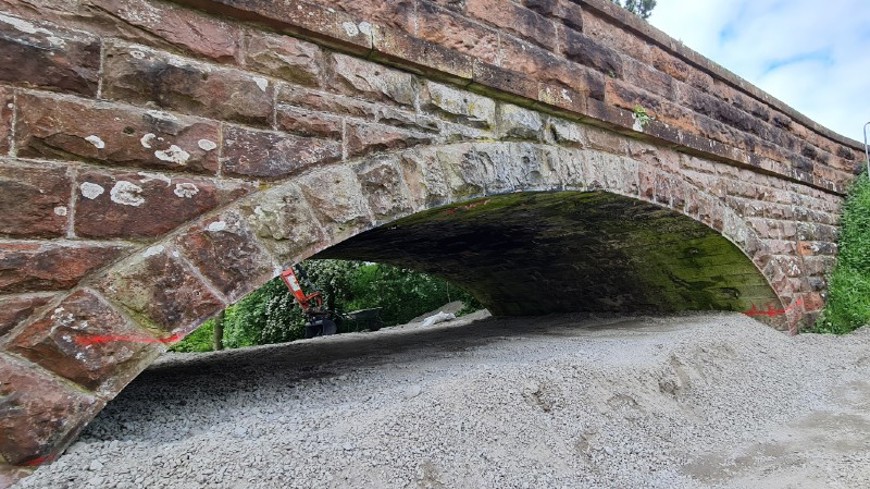Project profile: Great Musgrave Bridge
A bridge with a complicated history that’s helped shape how we work – including the establishment of a Stakeholder Advisory Forum where we engage with key stakeholders who advise on our choices in managing these assets.

Share this article
Location: Great Musgrave, Cumbria
Open to the public? Yes
Completion: Autumn 2023
Learnings from Great Musgrave
We know there’s been a lot of interest in the bridge and the works delivered. We have listened to feedback and made substantial changes to how we make decisions on managing the estate.
Our Stakeholder Advisory Forum, made up of organisations with an interest in our work, provides expertise and advice to support decision making on schemes such as this. We’ll continue to listen to community views to help inform our ways of working.
Find out more about our approach to infilling. You can also find our up-to-date works programme, which shows planned future major works over the next 12 months.
Explore our website to find out more on other work including Wheatley Viaduct, Pensford Viaduct, Boleside Footbridge and Aurs Burn Viaduct.
History
Financed by a group of wealthy local patrons (‘The Appleby Group’), who were led by a local dignitary, retired Admiral Russell Elliot, the EVR line was promoted as an important link between the North East and the West.
The line opened to mineral traffic on 8 April 1862, connecting Clifton and Kirkby Stephen East. It travelled over multiple river crossings, at Scandal Beck and the River Eden near the village of Great Musgrave.
The Eden Viaduct was an impressive 221ft (67m) long with three spans of iron and reached 20ft (6m) above the river at its highest point.
The EVR line eventually became Eden Valley Junction, which connected to the former Lancaster and Carlisle Railway. Great Musgrave was the first station on the line to be completely closed in 1952, followed by Kirby Thore and Temple Sowerby.
In 1962 the viaduct over the River Eden at Musgrave was demolished and the EVR line was closed to passengers. In 1968 the Skygarth Viaduct was demolished. The Coupland Beck Viaduct remains.
With the privatisation of British Rail in 1997 the British Rail Board became the organisation responsible for disposing of non-operational railway land and structures. This later became BRB (Residuary) Ltd.
We took over management of the bridge, and the wider Historical Railways Estate (HRE), on behalf of the Department for Transport (DfT) in 2013.
About the structure
Great Musgrave Bridge carries the B6259 over the former EVR railway line.
The B6259 connects to the A66, a major trunk road in northern England, near Coupland and is one of the main east-west road links in the UK.
Track from the EVR line underneath the bridge has since been removed and land returned to private ownership. The bridge is built of sandstone and limestone blocks.
The central arch is formed from a single row of stone blocks which reduce in size towards the highest part of the bridge (known as the crown). Like many of the bridges and stations on the line, the stone is believed to have come from the large red sandstone quarry near Cliburn Station.
The height of the south roadside parapet has previously been lowered to improve sightlines for oncoming vehicles. The bridge has a local landmark status as a recognisable feature in the landscape.
The bridge has some historical value by association with the EVR line, which was designed by eminent railway engineer, Sir Thomas Bouch.
The Eden Valley Railway Trust aspires to reopen the line, with hopes of restoring the track under Great Musgrave Bridge.
A timeline for Great Musgrave Bridge
When the government abolished BRB (Residuary) Ltd, maintenance responsibility and all associated liabilities for the HRE passed to the Highways Agency in 2013. Highways Agency became Highways England in 2015, then National Highways in 2020.
1994
British Rail is privatised, with BRB (Residuary) Ltd becoming the organisation responsible for disposing of non-operational land and structures. The structures in the HRE all pass to BRB (Residuary) Ltd.
1996
In November, Cumbria County Council (CCC) informs the BRB (Residuary) Ltd of a minor bridge strike. Recommended work includes pointing up stone joints in parapets and grout voids. Decision is made to postpone work until the next detailed examination, in 1998.
1998
CCC carries out a BD21/97 assessment* - the bridge fails. It is recommended that a 17-tonne weight restriction should be put in place. Work to repoint the arch barrel would increase the bridge’s capacity to the “full 40 tonne assessment loading”. No repair work is carried out following the assessment.
*A BD21/97 assessed the capacity of a bridge for live loads up to 40 tonnes. This has since been replaced by CS454. Capacity assessments such as these are the responsibility of the Local Highways Authority, in this instance CCC. Weight restrictions for bridges are also applied by Local Highway Authorities, not BRBR as was or National Highways.
2009
A Strengthening and Options Report carried out on behalf of CCC in September highlights the bridge’s condition as ‘unchanged’. It suggests that repointing the arch would restore full capacity of the bridge; 40/44t (at a cost of around £10k estimate). A weight restriction of 18 tonnes on the bridge is recommended by BRB (Residuary) Ltd to CCC.
The repointing work is not carried out, and a weight restriction isn’t applied by the CCC, which is the Local Highway Authority*.
*It's the Local Highway Authority’s responsibility to apply weight restriction over a bridge.
2012
In March BRB (Residuary) Ltd repoints the arch barrel, restoring the bridge to its full live loading capacity. It also re-beds dislodged blocks from the parapets.
2013
The DfT passes management of the HRE to the Highways Agency.
2015
During an annual bridge visual examination, we record flooding under the bridge.

(Image taken during 2015 exam showing flooding under the arch at a distance)

(Image taken during 2015 exam showing flooding under the arch closer to the bridge)
2017
We place clean stone under bridge to allow for safe working due to ongoing flooding below the arch of the bridge.

(Image taken during 2017 exam showing flooding under the arch closer to the bridge)

(Image taken during 2017 exam showing the clean stone we place)
A timber four post fence is installed to both sides of the arch to stop access under the bridge.
During a detailed examination in August, we note some joints between the masonry in the arch of the bridge have opened to 40mm in depth, with an average of 25mm over approx. 5m2 of the bridge. There’s also a slight defect in the arch, sagging by 4mm at the crown of the arch.
2019
In May, Great Musgrave Bridge is added to a list for potential infill due to its ongoing deterioration.
2020
During our annual visual examination of the bridge in February, the examiner finds the crown of the arch has dropped again by a further 15mm (totalling almost 20mm now). On top of this, mortar loss has worsened significantly from 40mm to 170mm. Our job is to maintain our structures and keeping people safe is our priority.
In April 2020, we advise Eden District Council (EDC) of our proposal to infill the bridge. EDC confirms we can infill the bridge under ‘permitted development’, which means we don't need to apply for planning permission to do the work.
We also re-contact Eden Valley Railway Trust to confirm any firm plans for redevelopment that might be affected by our works. We don’t receive a response.
Several options are considered before infilling is progressed as the preferred solution:
- Repair the bridge – at an estimated cost of £50k (taking into consideration that repairs to the bridge carried out in 2012 had failed after only five years)
- Demolish the bridge – which we rule out because of the disruption caused to local people and traffic using the B6259
- Strengthen the bridge – at an estimated cost of £100k
- Infill the bridge - at an estimated cost of £124k
Based on our options we decide to infill the bridge for the following reasons:
- It's a longer-term safe solution, and the bridge won’t need future work for a significant amount of time
- It's the best value for money in the long-term. As an organisation funded by the taxpayer we need to comply with a ‘public spending’ assessment
- Since 1998, the Local Highway Authority hasn't put in place a recommended weight restriction on the bridge, and we know it’s still being used by heavy good vehicles weighing up to 40 tonnes
- The infill could be removed at a future date
2021
Work to infill the bridge begins on 24 May under Permitted Development as agreed by EDC.
On 28 May we’re contacted by EDC who inform us that they “are looking to make an assessment as to whether these works constitute Permitted Development or whether planning permission should be sought.” They also ask that works do not start.
Work is already under way and is completed on 23 June 2021. We use a granular fill, topped with lightweight concrete. We then seed it with grass and native wildflowers so that it blends into the local landscape. This work costs £124k.
The image gallery below shows infilling work taking place.
In June EDC informs us of the formal investigation to consider whether the works are Permitted Development.
In July EDC concludes its internal review and confirms that the infill at Great Musgrave Bridge is Permitted Development. It's agreed that full planning permission should be applied for within a year.
Following criticism of the completed infill, we pause any infilling projects giving local authorities and other local groups more time to consider how our structures might fit with local plans for walking, cycling routes and heritage railways.
We establish the Stakeholder Advisory Forum in October, with representatives from DfT and other key stakeholder organisations such as Sustrans, railway heritage organisations, ADEPT, The HRE Group, Natural England, Historic England and Historic Scotland. This Forum advises on heritage, ecological or future re-use potential for structures where infilling or demolition may still be solution to managing issues with the structure.
2022
In June, we apply for full planning permission. As part of this process, we write back to Eden Valley Railway Trust to understand the progress of its long term plans for the reopening of the former EVR line, asking for expected timescales and funding. This information will be included in our submission, informing the planning authority on timings of when the infilling could be removed to make way for a new railway. Unfortunately, the Trust's plans are not sufficiently developed to provide that information.
After consideration EDC rejects our planning application, concluding that the infill should be removed and the bridge restored to its condition prior to the infilling.
We respect the decision and don’t appeal against it. Our new process of managing the estate, has full stakeholder engagement, meaning we will review each structure against a range of criteria, not only for repurposing but also for heritage or ecological value.
2023
In spring we cored two holes and broke out sections of the concrete, which came out as expected.
This preparatory work helps in the development of a detailed plan for removing the infill below the bridge safely and expeditiously. This is separate to any strengthening work required so the bridge can be reopened for safe public use.
Works began on 17 July.
Week 1
We installed a road closure so our contractor could set up our site compound safely.
We know road closures cause disruption and have made special arrangements with the community to use the bridge, while it’s been safe to do so. This includes a local farmer transporting their sheep between fields, as well as the local primary school coach transporting children for the last three days of term. Some local traffic was also given safe passage, which has been by exception.
Once coring work begins, we’ll be unable to allow traffic to use the bridge and will escort pedestrians, cyclists over safely.
We’d like to thank the local community and the travelling public for their patience while we work.

(Contractors oversee the safe movement of sheep over the bridge)

(Road closure in place while contractors set up the site for coring of the materials to begin)
Week 2
Coring of the foamed concrete beneath the bridge is under way and progressing as expected.


We’ve needed to carefully remove some of masonry blocks from the southern parapet to allow for safe access in preparation for coring on that side of the bridge. We’re storing these carefully so they can be replaced later.

We also started the process of hydraulic bursting too, where we’re applying pressure to gently break up the concrete.
Week 3
It’s been rainy and wet this week as the Great British summer gets under way, and we’ve been making steady progress while making sure that we maintain a safe environment despite the potentially slippery conditions for our teams and for people using the pedestrian route that is staying open across the bridge.
We have excavated around 2 metres under the arch on the north side of the bridge now, and are using smaller, hand-held equipment on the areas closest to the bridge arch. We are monitoring the bridge’s condition as we go to build a picture of the work that will be needed to strengthen it when the infill is removed.
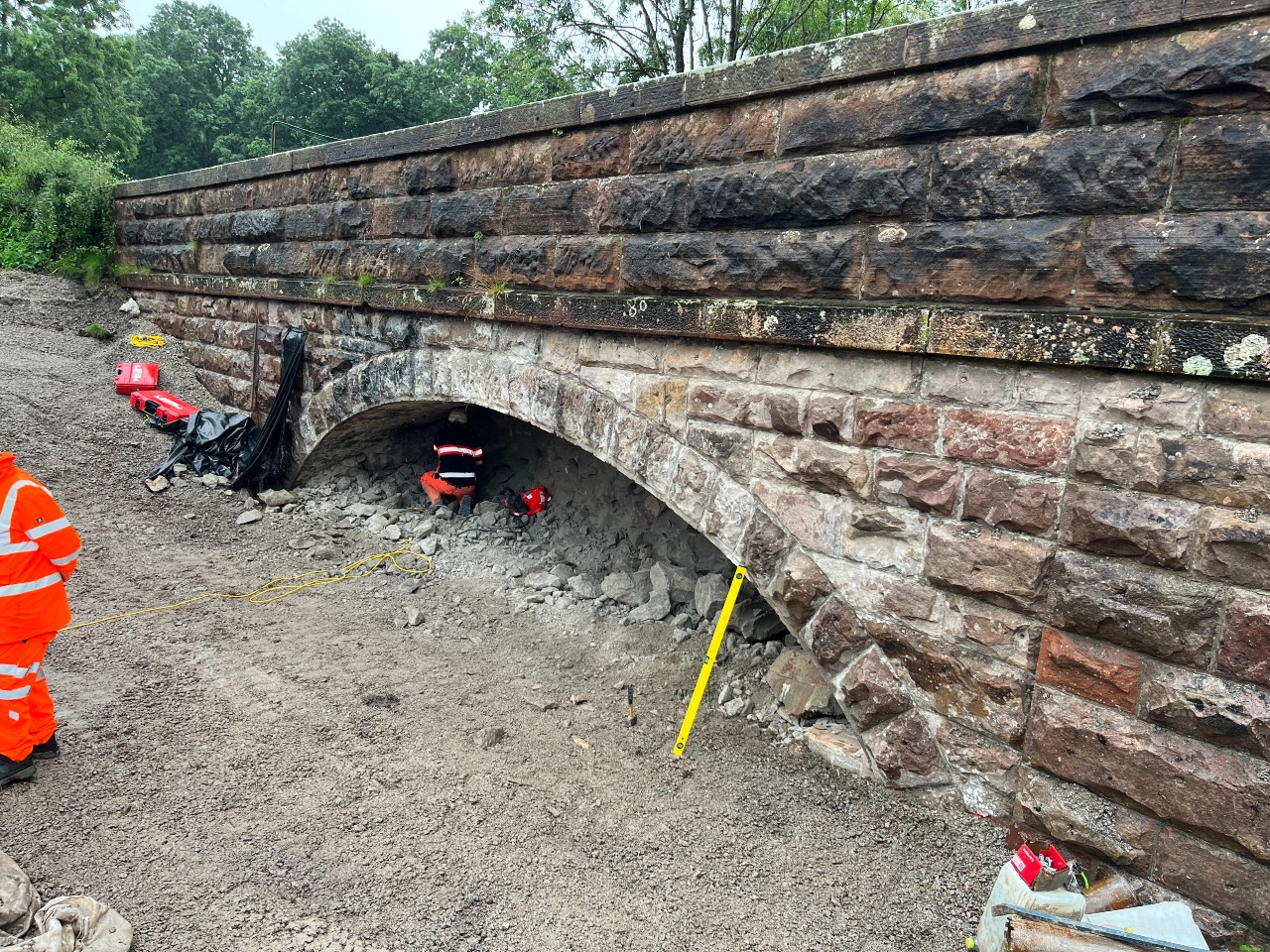


Week 4
We’re nearly one month in to our work to remove the infill at Great Musgrave Bridge and we're making steady progress. This week we started drilling circular cores into the infill material from the south side of the bridge, similar to what we’ve been doing from the north side. Some of these have now reached the full width of the bridge. Removing the infill in this way enable us to protect the structure as we go, and assess and carry out repairs.

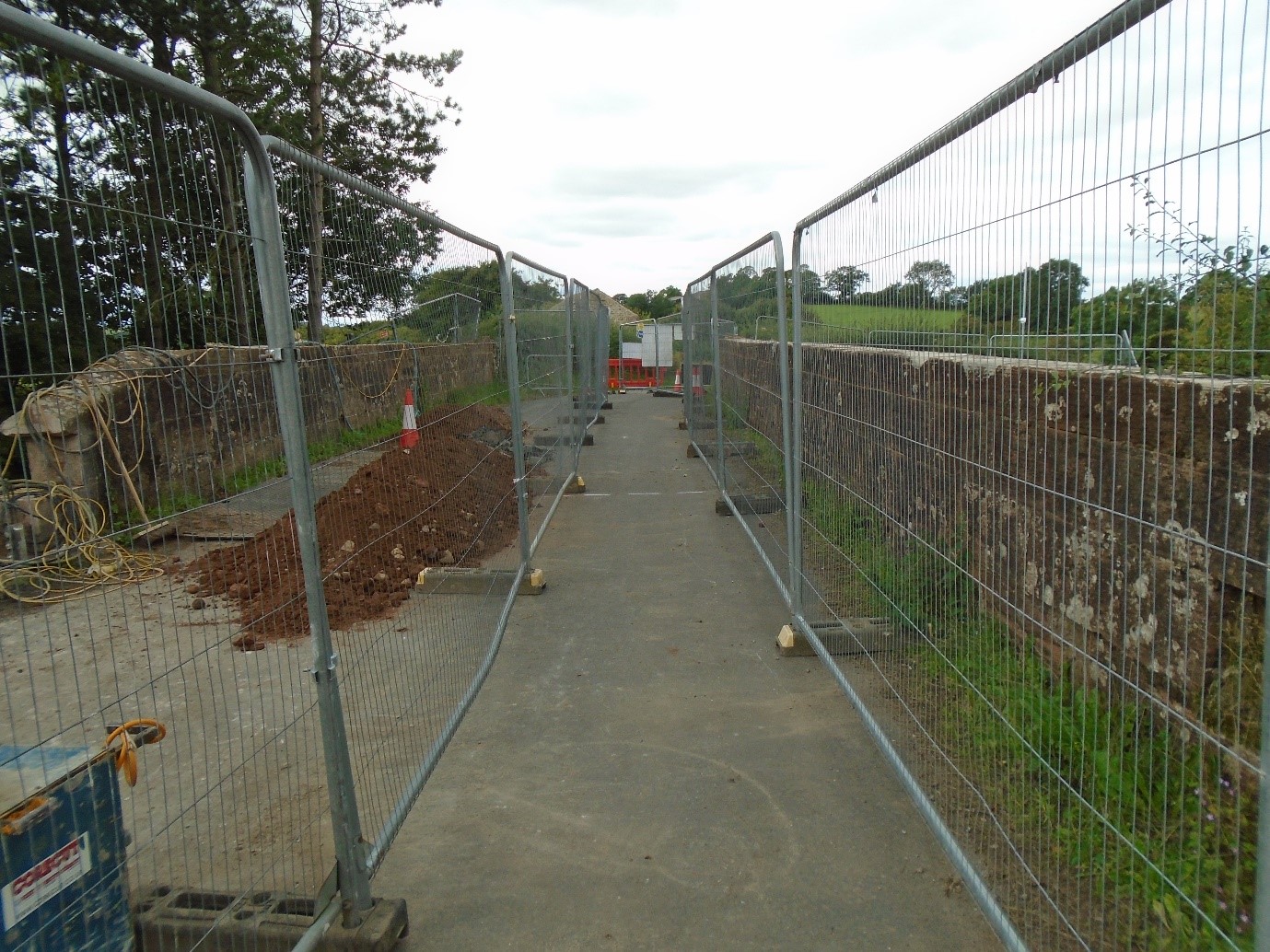
Week 5
There was a lot of media interest last week about our work and the steady progress we’ve made at the bridge.
We completed hydraulic bursting of the south side of the arch this week. We’ve been discouraging bats from moving back into the arch before our work is complete.
Bats love our tunnels, bridges and viaducts, and we created new habitats for the local bat community following our work in 2021. We’re pleased to report the boxes are being used (as you’ll see from the number of droppings in the photos further down the page).

(Cored section of concrete that’s been broken using hydraulic bursting technique)

(First view of opening beneath arch)
Week 6
This weekend our contractors created safe access over the bridge for riders taking part in ‘On Yer Bike', the Upper Eden Rotary Club Ride is an annual event for cyclists of all abilities.
Colleagues cheered riders on, offering refreshments from their water station. We were really pleased to have supported riders taking part in this local event as we know it’s very popular.
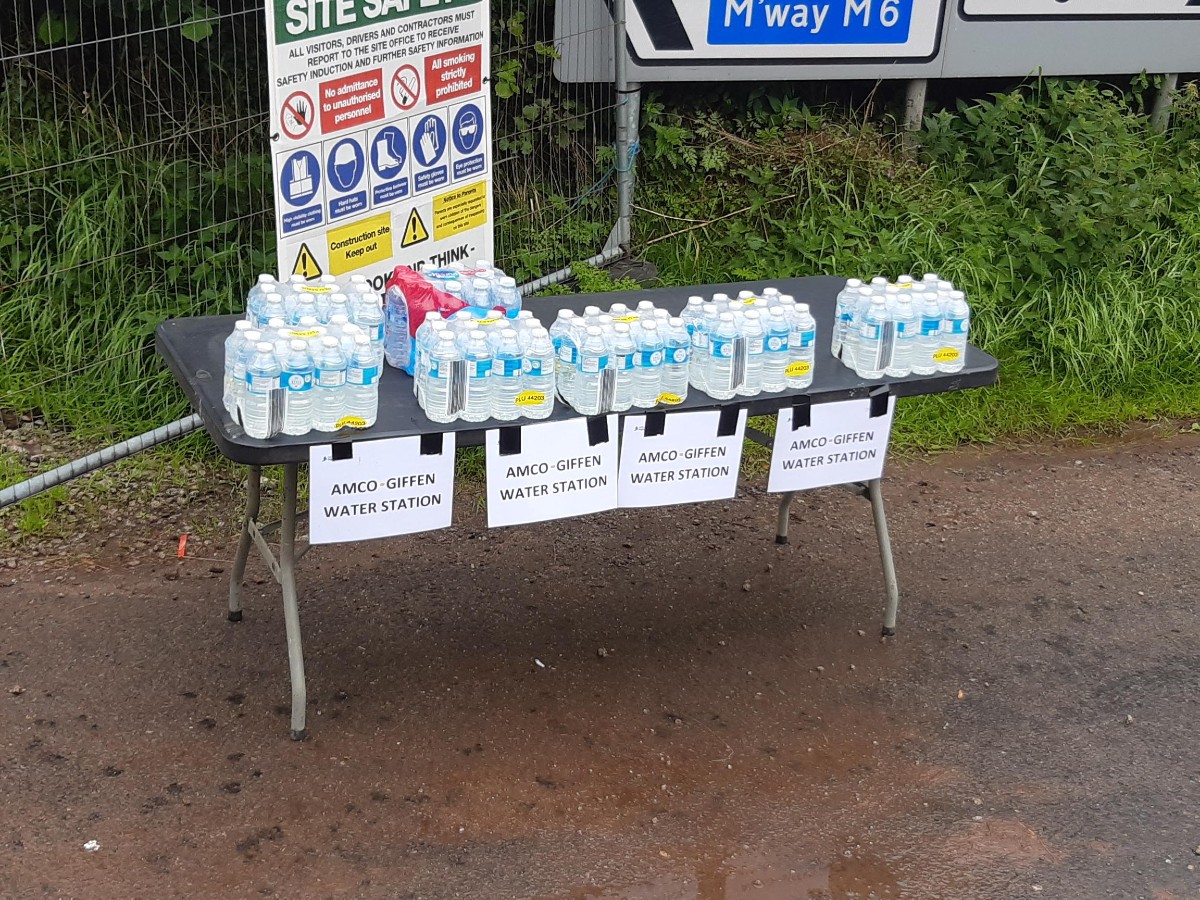
(Water station provided by our contractor for cyclists)

(Cyclists taking part in local charity bike ride making their way over the bridge)
This week we removed the last sections of foamed concrete from beneath the arch.
Some of the gravel fill has also been removed to provide a safe working height for the team to carefully start to clean the stonework ahead of a full examination by our engineers.

(View of arch following removal of foamed concrete)

(Contractor cleans arch to remove residual foamed concrete)
Week 7
This week we carried out a fingertip examination of the entire arch, marking up all areas of the bridge in need of repairs.
A capacity assessment (carried out to assess the load carrying capacity of a bridge) will be now completed after repairs.

(Close up view of arch after removal of all the foamed concrete)

(View of the arch where work has started to remove the fill material between the abutments and embankments)
Week 8
This week we’ve been focusing on continuing to remove fill material, digging out the structure from the embankment and reinstating the old railway cutting slopes – as you can see from photos below this work is nearly complete.
We know that many people are interested in our progress on the bridge, but we need to ask everyone not to try and access any fenced off areas unless by prior arrangement with our site team; building sites can be dangerous places.

(Work to restore old railway cutting slopes to the north side of the bridge.)

(Buried sections of the bridge now visible)
Week 9
Now that infill removal work has finished, we’re focusing on repairing the bridge, returning it to its condition prior to our works and ready for reopening to the public for safe use.
This week we invited Westmorland and Furness Council’s enforcement officer and conservation officer to site, showing progress made and explaining our repair work methods.
We know the mortar mix has been a talking point and we discussed this with the Council officers. Together we looked at the nature of previous interventions at the bridge during its lifetime and it was agreed that the process we were using had no significant negative impacts on the integrity of the bridge.

(Representatives from Westmorland and Furness Council on site this week with the team)
The Council are happy with the works that have been conducted so far and have confirmed they are content with the details of the final stages of work planned.
Week 10
This week we received the good news that, when we’ve finished our work, we will be able to reopen Great Musgrave bridge without a weight restriction.
The report we commissioned, known as the CS454 Assessment Certification used a more refined technique than the previous assessment by the council.
It confirms that, despite the bridge’s capacity being previously limited, our refurbishment work and resurfacing of the deck will remove the need for a weight restriction, restoring the bridge to full capacity.
We commissioned the report in agreement with Westmorland and Furness Council, who are the local highway authority for the B6259 over the bridge and have shared the findings with them.
After our work here is finished, we’ll continue to inspect the bridge every year and carry out any necessary repair work to ensure it can continue to be safely used.
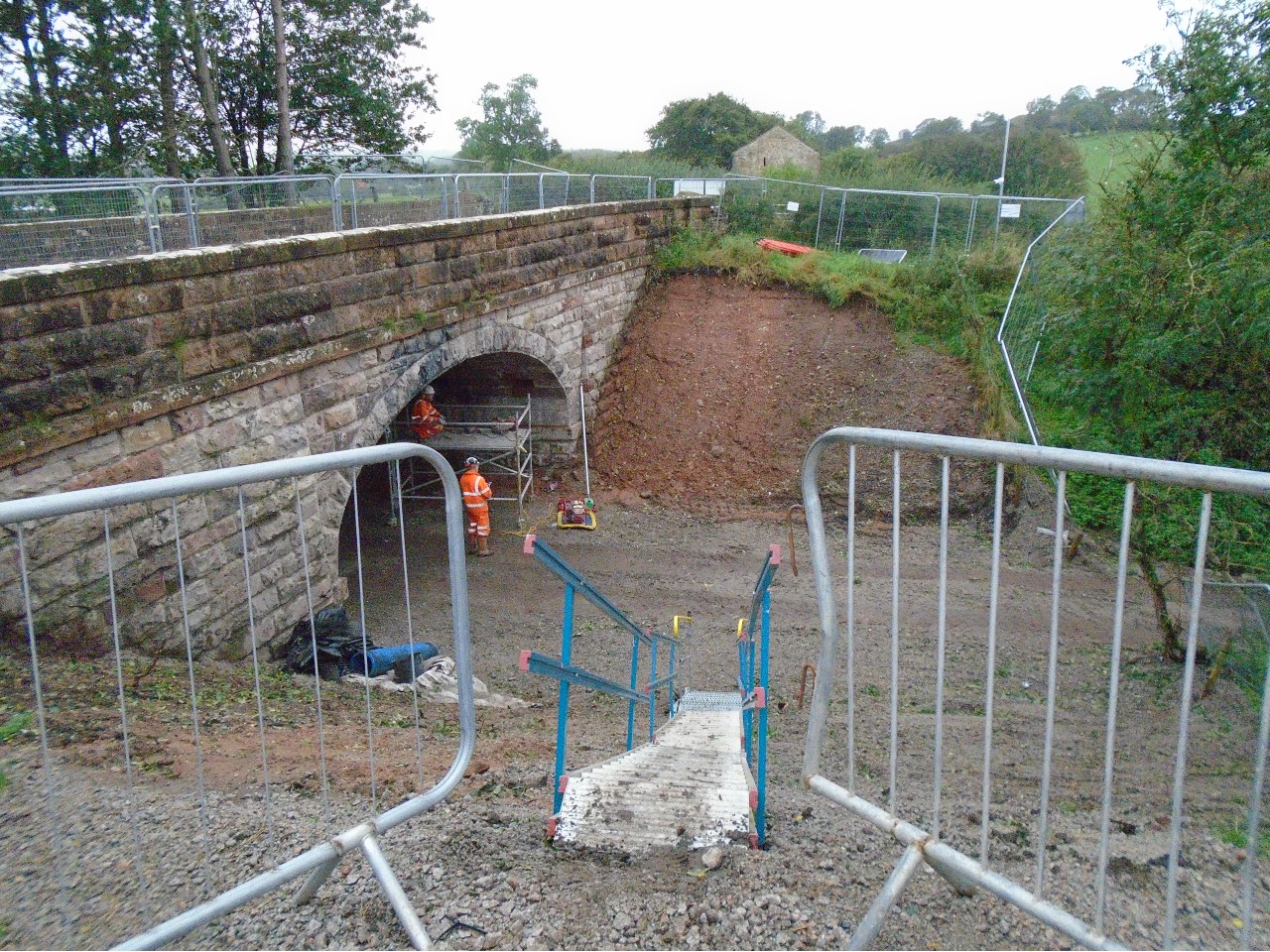
(Repairs being completed under the arch)

(View of the bridge where infill is carefully being removed)
Week 11
This week we restored the parapet we disassembled for safe working access.

(South parapet reinstated)
We also completed removal of the engineering infill beneath the arch, the stone placed in 2017 to provide a safe platform for our examiners will remain.

(Photo of bridge in January 2021 prior to our infill works)

(Bridge after removal of infill beneath the arch)
Week 12
We installed new asphalt on the road surface of the bridge ahead of the bridge’s reopening for public use. Once our refurbishment works are complete the Great Musgrave bridge will be able to safely carry vehicles without the need for a weight restriction.

(Road surface being removed)

(New asphalt road surface ready for white lining)
Week 13
This week we’ve been focusing on getting the bridge ready for the reopening of the road, the B6259, which runs over the top.

(View of arch on the north side of the bridge October 13 2023)

(View of arch on the south side of the bridge October 12 2023)

(Stonework repairs to the arch)
Despite the wet weather we’ve been able to complete the landscaping of the embankments, installing protective matting to help retain topsoil. It's a natural material and will break down over time.

(View looking south showing the matting used to retain the topsoil)
About the fill material
All fill material has been removed and moved to the north side of the bridge, as agreed with the local landowner.
We wanted to make best use of the fill material and before removal works started, we made arrangements for its reuse locally thereby minimising the cost and environmental impact of moving it longer distances.
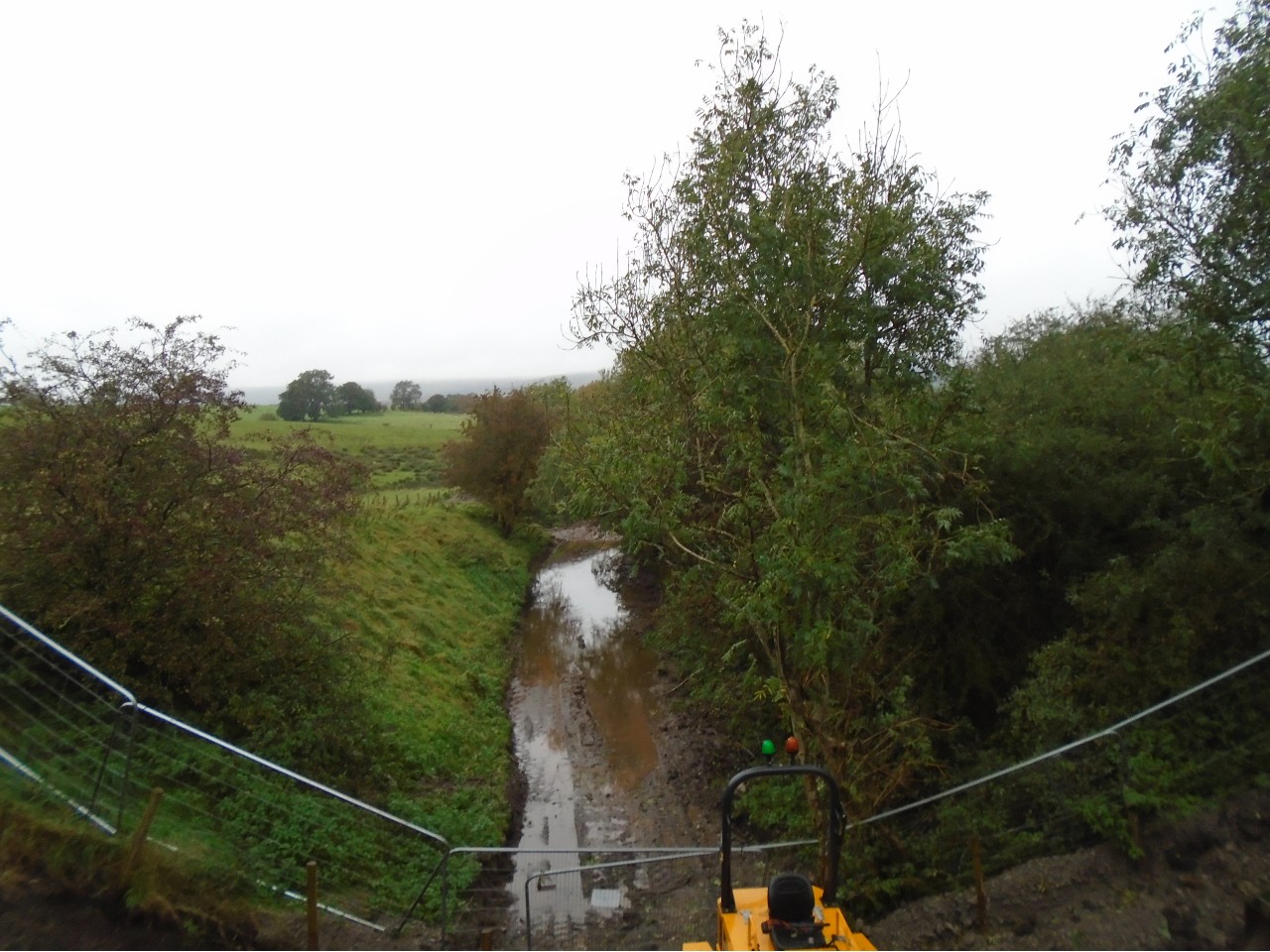
(View from the bridge looking north the waste fill material removed has been placed on private land as agreed with the local landowner)
About the bridge
A qualified engineer visited site to confirm that refurbishment works are satisfactory against the conditions set out in the capacity assessment. The Highway Authority, Westmorland and Furness council, who are responsible for the road the bridge carries have agreed it can safely reopen to all traffic. Road closures will be removed around 2pm on Friday 13 October.
We’ve been in close contact with the Enforcement Officer at Westmorland & Furness Council, who has been content with works throughout, having visited our site on 20 September with the Conservation Officer. A follow up meeting is being arranged to formally close the case; we’ll share updates on this visit in due course. We’ll also share the final cost of the works as soon as we can once we’ve undergone all necessary contractual processes with suppliers involved.
Next steps
As with all HRE structures, we'll carry out annual inspections of the bridge and deliver any necessary repairs to keep the bridge and road open for safe use.
Image gallery
What stage is it at?
Works completed in October 2023 at a cost of £352,000, which includes the removal of the infill and refurbishment work. We replaced dropped and damaged stonework, removed friable mortar, repointed open joints and resurfaced the bridge deck/road to ensure it's less permeable. Once all work was complete we then landscaped and lay topsoil on the embankments close to the bridge.
"We are passionate about our role in protecting Britain’s railway heritage. Our priority is to maintain these old structures to prevent the risk of harm to the public. We’ll keep listening and responding to local community needs to inform our decision on the management of the Historical Railways Estate."Hélène Rossiter, Head of Historical Railways Estate at National Highways
